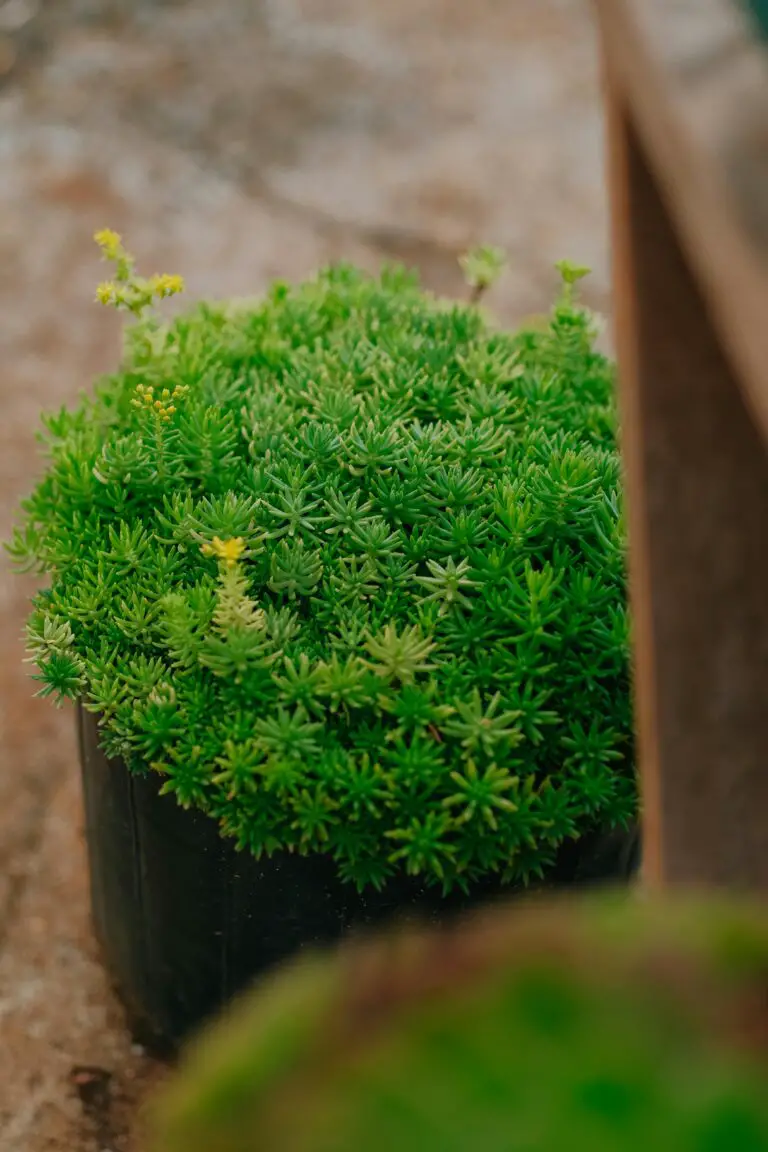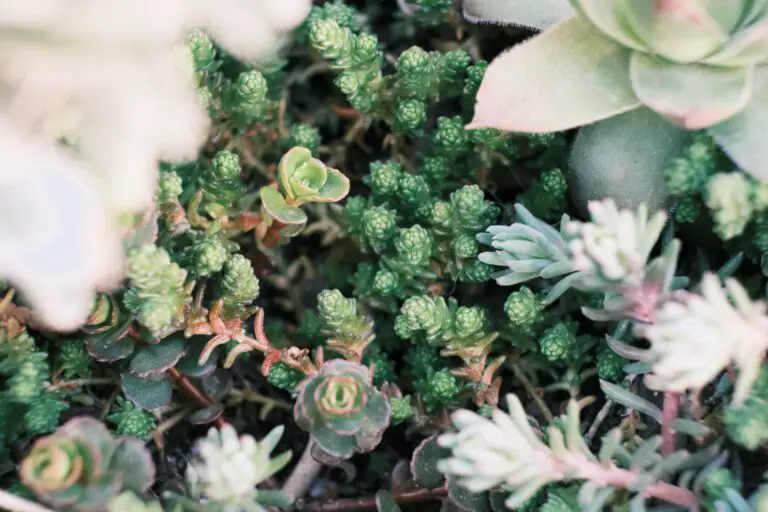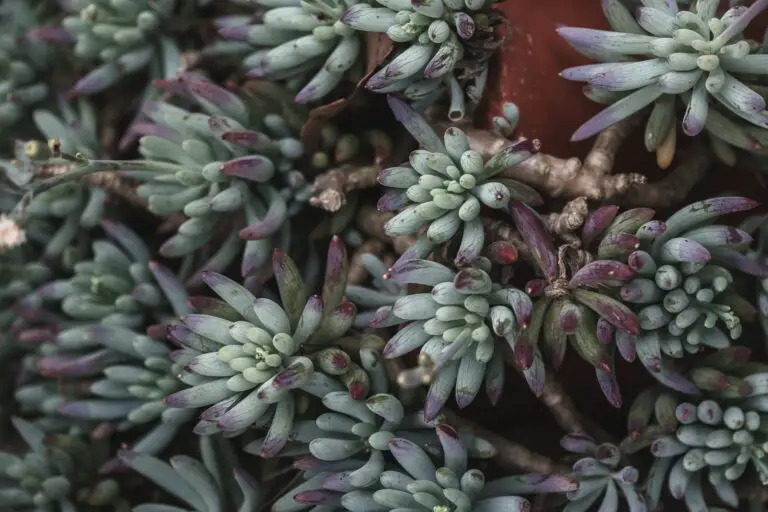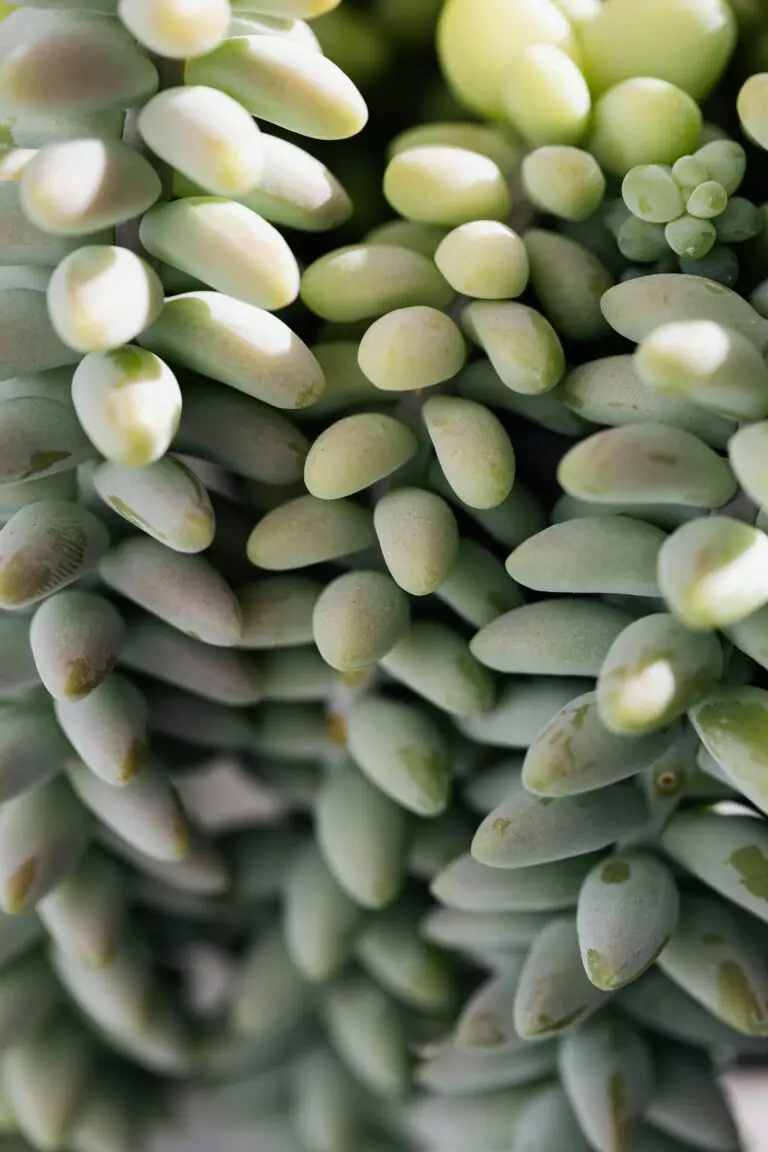Introduction: Embracing the Sedum
Welcome to the verdant world of sedums, the resilient troopers of the succulent kingdom. Often overlooked by the enthusiastic green thumbs aiming for the more ostentatious blooms, sedums hold their own with a quiet dignity that demands recognition. Let’s take a linguistic stroll through the succulent gardens where the name ‘Sedum’ itself rolls off the tongue as softly as a whisper, yet stands firm in its botanical significance.
Pronouncing ‘Sedum’ correctly – ‘see-dum’, with a stress on the first syllable – can indeed be a badge of honor, reflecting not just your love for gardening but a genuine understanding of it. Imagine yourself at a local plant nursery, confidently requesting a ‘Sedum Autumn Joy’ or discussing the hardiness of ‘Sedum Spurium’. It’s not merely about getting it right; it’s about belonging to a community that cherishes every leaf, stem, and petal. And for those moments when you’re weighing the merits of mulch for your leafy friends, here’s an insightful read on healthy succulent growth.
Embracing these fleshy petaled wonders can start in your very own backyard. Take Sarah, for example, a school teacher with a penchant for all things green. She started with one tiny sedum cutting on her kitchen windowsill. Now, she’s the go-to ‘Sedum Whisperer’ in her neighborhood, propagating joy with cuttings for everyone who shows interest. It’s about sharing knowledge, from sun requirements to succulent care, and of course, the subtle art of pronunciation.

Turn your gaze to the sedums that line your path in rock gardens or that adorn the walls with their verdant cascades. These are not just plants; they’re storytellers whispering tales of survival and adaptability. They remind us that in the right conditions, such as using quality succulent care tips, we too can thrive amidst the rocks and droughts of life.
This introduction is just a glimpse into the vast expanse of the sedum universe. As we delve deeper, let us articulate our care, our understanding, and our love for these rugged beauties. For in learning how to say ‘Sedum’ correctly, we begin to understand the language of succulents, and that is the first step to mastering the art of succulent gardening.
Linguistic Roots: Understanding Sedum Pronunciation
So you’ve brought a brand new Sedum home, and it’s just sitting there, waiting for you to brag about it to your pals. But hold on—are you certain you’re announcing your new green buddy’s name correctly? Fear not! You’re about to become a Sedum articulation aficionado.
First off, let’s get scholarly and plunge into sedum’s past. The word itself has Latin roots—quite fitting for a plant, don’t you think? It’s derived from ‘sedere,’ meaning ‘to sit,’ which perfectly describes these low-growing, ground-covering beauties. Got a rock garden? These guys are the ultimate babysitters for your stones.
Now, onto the nuts and bolts of saying it right. Phonetically, you’re looking at a snappy ‘SEE-dum.’ Think of it as if you’re instructing someone to ‘see’ something amazing, followed by a ‘dum’ sound as in ‘drum’ without the ‘r.’ Simple, right? Try it out next time you’re chatting about your love for cultivating these succulents indoors—it’ll definitely impress.
Why all this fuss over pronunciation? Well, it’s all about paying homage to the intricate history and identity of these resilient plants. By pronouncing ‘sedum’ accurately, we’re connecting with centuries of botanical heritage and showing off our plant-savvy swagger.
It’s a bit like learning the local lingo before heading on vacation—you want to sound cool and in-the-know, not like you’ve got a mouthful of marbles. So, repeat after me: SEE-dum. You’ll be turning heads at the plant nursery in no time!

Remember this the next time you’re leafing through a plant catalog or trying to impress at the garden club meetup. Behold the mighty SEE-dum, as unique in its nomenclature as it is in its drought-dodging moxie. Let’s give a standing ovation—nah, a sitting ovation for sedum’s sake—to this plucky little plant that continues to captivate and charm gardeners everywhere.
Sedum’s Garden Debut: Identifying Varieties
Welcome, green-thumbed enthusiasts, to the vibrant world of sedums! These succulent beauties offer a palette of textures, colors, and shapes that can transform any garden into a living tapestry. But before you can cultivate your own sedum sanctuary, mastering the art of pronunciation is key. Let’s embark on an auditory journey through the rich diversity of sedum species, ensuring you’ll be the most articulate advocate for these resilient plants.
A familiar face in the sedum family is Sedum acre, fondly known as the ‘goldmoss’. Imagine a golden carpet unfurling across your garden bed, with tiny, star-shaped blooms—a sight to behold, surely! And when mentioning it to fellow plant lovers, softly emphasize the ‘a’ in acre, as if whispering a secret to the earth itself.
Getting the Hang of Hylotelephium
Did you know some sedums go by another name? Meet Hylotelephium telephium, also a member of the sedum crew. This species, often called “stonecrop,” is like the stalwart knight of your garden, armored in rosettes and ready to weather any storm. Learn its lyrical name, and you’ll feel like a botanical bard.
For a dose of visual learning, take a peek at this video that captures the essence of these hardy plants, showing sempervivums mingling with sedums in a tapestry-like display. The montage not only showcases varieties but also offers a chance to hear how to pronounce their captivating names.
Diving deeper into the sedum spectrum, we encounter Sedum reflexum, also known as “blue spruce.” This charmer mimics the aura of a miniature blue spruce tree, each needle a statement of tenacity. When you articulate ‘reflexum,’ let your voice mirror the plant’s upright nature, strong and unwavering.
Now, to thrive alongside your sedums, enriching your gardening know-how is essential. Grasp the nuances of succulent care to ensure your sedum varieties remain as jubilant as your newfound pronunciation prowess.
Pronounce with Purpose
As you converse with fellow gardening aficionados, remember to roll ‘sedum’ off your tongue with the ease of a leaf fluttering to the ground. Each variety, from the robust Sedum spectabile to the delicate Sedum sieboldii, has a tale to tell, and it’s your voice that will bring those stories to life.
Craving more succulent wisdom? Venture through the insights found right here, where a treasure trove of sedum care tips and tricks await. Ready your tools and your tongue, for the garden of sedums beckons, and it’s time to answer its call with confidence and clarity.
Verbal Bloom: The Elegance of Speaking Sedum
Embarking on the journey of speaking sedum does more than just polish your pronunciation—it bridges the gap between you and the vibrant community of succulent enthusiasts. Whether you’re conversing at local gardening clubs or chatting online with fellow green thumbs, pronouncing the word ‘sedum’ correctly is the leafy handshake that says, “I’m one of you.”

Consider Jessica Green, a seasoned gardener from the rocky slopes of Colorado. She recalls, “The first time I correctly articulated ‘SEE-dum,’ the heads of my local gardening society turned. It wasn’t just my ability to speak the lingo; it was recognizing that I, too, held these succulents in high esteem, worthy of their proper name.”
Harmonious Horticulture: Practice Makes Perfect
Enhancing your sedum speak takes practice. Start by observing the experienced gardeners around you. Notice the gentle cadence in their voices as they glide over the syllables of ‘SEE-dum.’ Then, replicate it. Picture yourself discussing the merits of Sedum spectabile or reciting the rosettes of Sedum morganianum—a practice both soothing and affirmative.
Remember to infuse your dialogue with passion, for it’s not just about the technicalities of language; it’s about conveying your dedication to these resilient plants. Like Kyle Barnes, an urban grower in Boston, says, “When I talk about my rooftop sedum collection, I make sure my voice reflects the care I put into nurturing them. It’s about respect—for the plants and for the craft.”
Enthusiasm for sedum isn’t merely expressed through words but in the ebullience with which they’re said. In the grand symphony of gardening, your voice is the instrument that expresses the timeless beauty of these succulent marvels—a beauty shared and appreciated within the sprawling tendrils of the sedum aficionado community.
Cultivating Confidence: Tips for Growing Sedums
Are you ready to dive into the world of sedums, those resilient and charming succulents that have captivated gardeners across the globe? Let’s roll up our sleeves and get our hands (just a bit) dirty with some down-to-earth advice that’ll have you speaking ‘Sedum’ fluently—both literally and horticulturally!
Choosing the Right Foundation: Soil Matters
First things first, selecting an appropriate soil for your sedums is crucial. These plants are the embodiment of the phrase ‘tough love’—they thrive in conditions that would make other plants throw in the trowel. Sedums prefer well-draining soil that mimics their natural rocky habitats. Imagine a mix that’s one part good times, two parts freedom—it’s all about airiness and drainage. The right soil is the strong, silent type; it doesn’t hold onto water like clingy clay.
Let There Be Light: Sunlight Needs
When it comes to soaking up the rays, sedums are like the sunbathers of the plant world. They love a good sun-kissed spot where they can bask in the glory of at least six hours of direct sunlight. It’s the secret to their healthy, vibrant look—like they’ve just returned from a plant vacation. While some stonecrops can handle a bit of shade, they might not be as colorful or robust, sort of like a tan line on an otherwise perfect summer glow.
The Fine Art of Pronouncing ‘Sedum’
Funny enough, knowing how to correctly say ‘sedum’ is a bit of a badge of honor among succulent enthusiasts. It’s ‘SEE-dum’, with emphasis on the ‘SEE’, as in “see how awesome my garden looks?” It’s a small detail, but in the gardening world, it’s the equivalent of knowing the secret handshake. So next time you’re amidst fellow plant lovers, drop the name with confidence and watch as heads nod with respect.
Gardening Skill: It’s More Than Just Talk
But remember, while pronouncing sedum properly may earn you some cred, it’s your gardening skills that will truly make your green companions flourish. Do you remember our friend who got the soil mix just right? Or that neighbor whose sedums always seem to be sun-kissed to perfection? That could be you with a little care and knowledge share.
Let’s take a look at a practical example. In this engaging tutorial, you’ll discover some hands-on tips for tending your sedums, particularly as they wake up in spring. Follow along and transform knowledge into blossoming success:
There you have it, aspiring ‘Sedum Whisperers’—with the right foundation, the perfect amount of sunlight, and the interplay of pronunciation prowess with gardening skill, you’ll cultivate not just sedums, but confidence too. Ready to get growing?
Propagation Pronouncement: Spreading the Sedum Word
Ever marveled at the lush tapestry of a sedum garden and wondered how such beauty proliferates? Sedum propagation is not just an art; it’s a communion with nature that speaks to gardeners of all strides. And let’s be honest, isn’t there a particular thrill in nurturing new life from just a fragment of a plant? Whether you’re a seasoned green thumb or a budding enthusiast, extending the lineage of these succulent wonders can be a delightful journey.
Imagine this: you’re sipping a cup of coffee, enjoying the morning breeze when a friend admires the vibrant sedum carpeting your balcony. A smile spreads across your face as you pluck a few cuttings, the velvety leaves barely grazing your fingers, and you pass them on. This simple act is the essence of sedum how to say it best: ‘I care, and so I share.’
Clear communication is the bedrock of successful sedum swaps. It’s about expressing not just the ‘how-tos’ but also the ‘whys’ of propagation. Why should one trim at an angle? Why is well-draining soil pivotal? Addressing these curiosities is essential. After all, imparting knowledge on providing the best care for cuttings ensures they stand the best chance of flourishing into robust plants.

Consider the joy that spikes when your cuttings spread roots and sprout young leaves. It’s akin to the elation of a linguist who finally learns to roll the R’s in a foreign language, a breakthrough moment signifying growth. Propagating sedum not only amplifies the green in your environment but also, quite literally, spreads the good word of sustainable horticulture.
There’s an unwritten script in the gardening community that thrives on exchange; it’s neither scripted nor mandated, but it flows naturally among those who value growth, in gardens and relationships alike. So, next time you’re dividing your sedum, remember that each cutting can be a tiny ambassador of your commitment to the verdant world. Let’s propagate the sedum and nurture an ever-expanding community of succulent whisperers, shall we?
Sedum Whisperer: Articulating Care for Succulent Enthusiasts
Seasonal Sedum Speech: Care Tips Throughout the Year
When it comes to caring for sedum, or “stonecrop,” as it’s sometimes affectionately known, synchronization with the seasons is key. Embracing the unique rhythms of the year can not only enhance your connection with these plump, picturesque plants but can also ensure a lush, vibrant garden space year-round. Let’s use our green thumbs to talk the language of sedum care across the seasons!
As the tender warmth of spring whispers across the garden, your sedums are just beginning to stir from their wintry rest. This is the time to clear away the remnants of the past, trimming back dead foliage to unfurl a clean canvas for new growth. Just as a gentle spring shower revives the earth, a moderate watering routine will awaken your sedums, prepping them for a season of growth. Remember, it’s like saying “hello” after a long sleep – be kind, be gentle.

High noon in the garden means summer has arrived, and with it, the robust sun calls for your sedums to stand strong. Now’s the time for vigilant care; keep the soil consistently dry between waterings to echo the natural arid habitats these succulents adore. It’s akin to sharing laughter with a friend on a long, sunny day – the conversation light, lively, and sparing.
Autumn dresses your sedum in a spectacular array of colors, a natural nod to their adaptability. As temperatures mellow, water usage drops, and it’s best to mimic nature here – allow the soil to fully dry, imitating the desiccated autumn air. Here, your words with the sedums are sparse but meaningful, preparing them for the silence of winter.
Winter’s hush is a period of rest and reflection. For your sedum, it’s a whisper of dormancy, a stillness beneath the frost. Minimal interaction is key; let them be, let them sleep, providing only the barest sips of water if they appear particularly dry. You’re listening now, giving space to your sedums as they huddle against the cold, dreaming of spring’s return.
Adapting your care tactics with the fluctuating dialogue of the seasons cements a kinship with your sedum collection. Each plant has its own dialect, its unique response to your seasonal overtures. Echo the environment in your care routine and watch as your sedums flourish, offering a lush tableau of succulent communion, no matter the time of year.
Sedum Syntax: Navigating the Language of Labels
Welcome to the enchanting vernacular of sedums, those resilient succulents that captivate our hearts and windowsills. As a Sedum Whisperer, you know the power of understanding sedum-speak. It’s like learning to decode a secret garden language that can lead to thriving, vibrant plants.
Let’s begin with a tale from a fellow enthusiast—you might recognize the experience. Picture this: You’re meandering through your favorite nursery when a label catches your eye. It reads “Sedum spathulifolium ‘Cape Blanco’. Partial sun. Well-draining soil.” Simple enough, but what does the ‘Cape Blanco’ denote? Ah, that’s the cultivar name, revealing that it’s a unique variety of the species, often with distinctive features or growth habits.
Deciphering the Sedum Code
Understanding the lexicon of labels is akin to unlocking a treasure chest. The term “partial sun,” for instance, is sedum lingo for “I like a splash of morning sunlight, but please shield me from the harsh afternoon rays.” And “well-draining soil”? That’s sedum for “I love water, but I can’t swim, so let it drain away, will you?”
A real-life example is our good friend “Sedum acre.” This little green mat of joy tells us a story in its label—one of resilience and adaptability. It prefers full sun, reflecting its love for a day basking in the glory of sunlight, and it states ‘drought-tolerant’ indicating that, like a desert nomad, it can survive with just the memory of water.
Labels also whisper hints about a sedum’s homeland, clues that tell us how to echo its natural habitat. Take “Sedum reflexum” or “Stonecrop”—its origins in rocky, alpine regions speak to a need for gritty soil and cool, exposed locations. Mimic that, and you’ll watch Stonecrop flourish and spread its starry flowers with abandon.
So, there you have it, fellow whisperers. By tuning into the language of labels, you give your verdant friends the best chance at life. Learning to say ‘sedum’ fluently means transforming your care routine into a dialogue of growth and vitality. Remember, every term is an insight, each phrase, a guideline. Now, go forth and speak sedum like a native!
Frequently Asked Questions
Ever whisper to your sedums and wonder if they’re listening? Maybe they’re just waiting for you to pronounce their name correctly! All jokes aside, it’s time to tackle some of the most common curiosities gardeners have about these resilient plants. So, let’s get chatty about sedum care, the ins and outs of their pronunciation, and those little tips and tricks that’ll make you a green guru in no time!
How Do You Say “Sedum”?
First things up, let’s clear the air on pronunciation. “Sedum,” the botanical name that sometimes twists tongues, is correctly articulated as “SEE-dum.” Think “See them?” but replace the ‘th’ with a ‘d’, and you’ve got it! Remember the time when you first tried to say “superfluous” and got tangled up? It’s a bit like that, but once you’ve got it, you’re golden.

Can You Spot the Difference Between Sedum Species?
If you’ve ever mixed up ‘Autumn Joy’ with ‘Dragon’s Blood’, you’re not alone! Sedums have such a wide variety of species, with over 400 in the family. Each has its distinct vibe, like the ‘Cape Blanco’ with its silvery leaves reminiscent of moonlight, as opposed to the ‘Gold Moss’ that lights up like a little sunshine in your garden. Real-life example – your neighbor’s envy when your ‘Cape Blanco’ steals the show in the moonlit garden party!
Any Tips for Remembering Sedum Names?
Remember the time you came up with a nickname for your pet based on its personality? You can apply a similar strategy to memorizing sedum species. Pair their visual characteristics with their names. A sedum with ruby-red leaves? Think ‘Dragon’s Blood’. A plush carpet of sedum on your rock garden? That could be ‘Gold Moss’. Associate, imagine, and conquer those names!
Caring for Your Sedum: Do’s and Don’ts
Caring for sedums is like that one low-maintenance friendship we all cherish; they don’t demand much, but a little attention goes a long way. Sedums love the sun like beach-goers love the summer. Plant them in a sunny spot but don’t let them burn. Picture this – imagine sedums with sunglasses and sun hats, basking yet protected. Water them, but not too much. They detest soggy feet as much as you do stepping in a puddle with socks on.
There you go, folks – the lowdown on ‘sedum speak’, recognizing the vast family of species, and nurturing these succulent buddies. Incorporating these FAQs into your gardening routine will not only boost your botanical eloquence but also make your garden the talk of the town!



